The Saint Lawrence River has huge economic impacts on both the United States and Canada. Grain, iron ore, coal, and other commodities moved along its system, making it one of the biggest international trade routes.
Beginning at the east end of Lake Ontario, the Saint Lawrence River flows about 1,900 miles to the Gulf of Saint Lawrence. That distance includes about 1,600 miles of the estuary — the biggest in the world. The enormous estuary is large enough that even minke whales and the ever-smiling beluga whales live in it for part of the year.
The river’s diverse ecosystem also makes it popular for fishing — bass, panfish, walleye, and northern pike are all common. Some of the smaller fish might be targets for northern watersnakes, but most snakes this far north don’t spend an enormous amount of time in the water. Additionally, they’re only active from about April to October, less if it’s a cold spring or early winter. Here are the 10 snakes you’re most likely to see in or around the Saint Lawrence River.
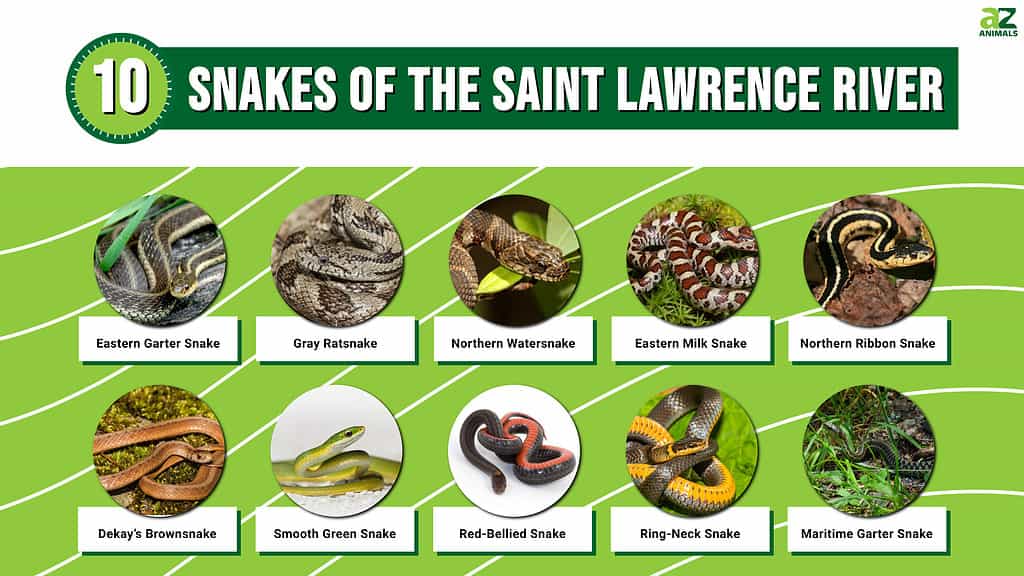
Read on for more detail about these snakes, their appearance, behavior, and diet.
1. Eastern Garter Snake (Thamnophis sirtalis sirtalis)
These earthworm-eating snakes are almost as well-adapted to the cold as the common European adder. The eastern garter snake is one of over a dozen common garter snake subspecies that are sometimes a challenge even for experienced herpetologists to identify accurately. Eastern garter snakes occur along the Saint Lawrence River almost to the mouth of the Gulf of Saint Lawrence.
Like other garter snakes, the eastern garter snake is semiaquatic and sometimes spends hours in the water. In addition to earthworms, eastern garter snakes eat frogs, toads, newts, salamanders, small fish, and insects.
Long and thin, they can grow to four feet but often stay smaller. Eastern garter snakes usually have three longitudinal stripes that vary in color from cream to orange with brown, olive, or black bodies. They’re harmless to humans, but their bite may cause irritation because their saliva contains toxins that work against amphibians and other small prey.
Feisty little snakes that often wind up food for bigger predators, eastern garter snakes squirm when you first pick them up. They’ll also bite and release musk from their cloaca, which they then manage to spread everywhere.

One of the most cold-tolerant snakes in the world, garter snakes are usually active early and later in the year than other species.
©Erik Agar/Shutterstock.com
2. Gray Ratsnake (Pantherophis spiloides)
One of several rat snake species, the gray rat snake is one of the few that keep most of their pattern as adults. Gray rat snakes are master climbers that are comfortable in the trees while they hunt small rodents, birds, and anything else they can grab.
This species is native to the midwestern U.S. to the western slopes of the Appalachian Mountains. Their northern range extends into southern Canada. Gray rat snakes are nonvenomous colubrids that have a lighter base color and blotches on their back. These snakes are long and lean but not skinny like garter snakes; they can grow to six feet long.

Gray ratsnakes retain most of their juvenile pattern as adults
©Jay Ondreicka/Shutterstock.com
3. Northern Watersnake (Nerodia sipedon sipedon)
Another of the harmless snakes that live in or alongside the Saint Lawrence River, northern watersnakes are expert swimmers. They prefer to eat fish and other amphibians, although their diet also includes other small animals as they can catch them.
As a member of the Nerodia genus, this is the only true water snake on our list. Northern watersnakes have extremely sharp teeth that curve toward the back of their mouth to help them catch and swallow their slippery prey. This is the most northerly-living watersnake species, but even it doesn’t come close to the garter snakes’ range and tops out a little past Montreal, Quebec, along the Saint Lawrence River.
These snakes can grow to about four feet long and have thick bodies with keeled scales. Younger individuals have brighter blotched patterns, but they darken as they mature.
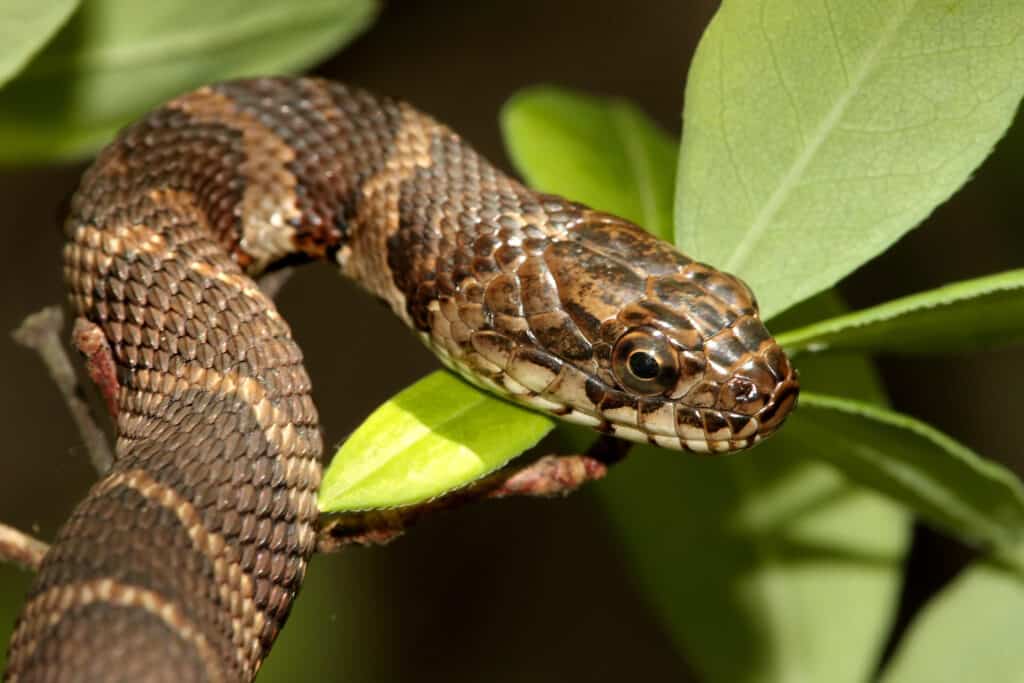
Northern watersnakes have extremely sharp teeth that curve toward the back of their mouth to help them catch and swallow their slippery prey.
©Steve Byland/Shutterstock.com
4. Eastern Milk Snake (Lampropeltis triangulum)
This little rodent eater often hangs out in forested areas, along rivers like the Saint Lawrence, and sometimes even in barns. Eastern milksnakes are harmless colubrids and a type of kingsnake, which means they also sometimes eat other snakes.
Eastern milksnakes can grow to six feet, but in northern areas often stay smaller. They’re nocturnal and usually rest during the day before going on the hunt for their next meal. Unlike rat snakes, eastern milksnakes aren’t selective and will eat anything they can overpower.
You can see these snakes as far north as Montreal, and they don’t live in the river. However, they’re happy to live alongside it.
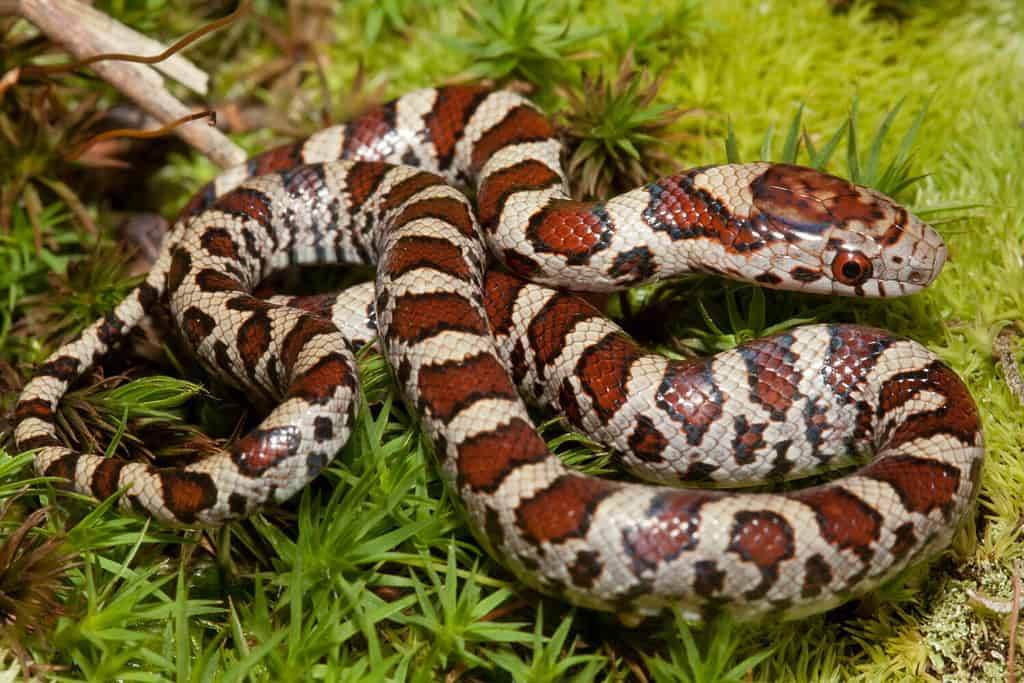
Eastern milksnakes can grow to six feet, but in northern areas often stay smaller.
©Nathan A Shepard/Shutterstock.com
5. Northern Ribbon Snake (Thamnophis saurita septentrionalis)
Like their cousins, the garter snake, northern ribbon snakes are semiaquatic. They live along the edges of marshes, lakes, and rivers with a diet similar to others in the Thamnophis genus that includes various amphibians, tadpoles, fish, and insects.
Northern ribbon snakes have three bright yellow or white lines down the length of their dark brown or black bodies and a black head. They’re small and thin, only growing to about two feet long. Unlike their cousins, northern ribbon snakes are not as cold-tolerant. They only occur near the headwaters of the Saint Lawrence River and don’t go very far downstream from there.
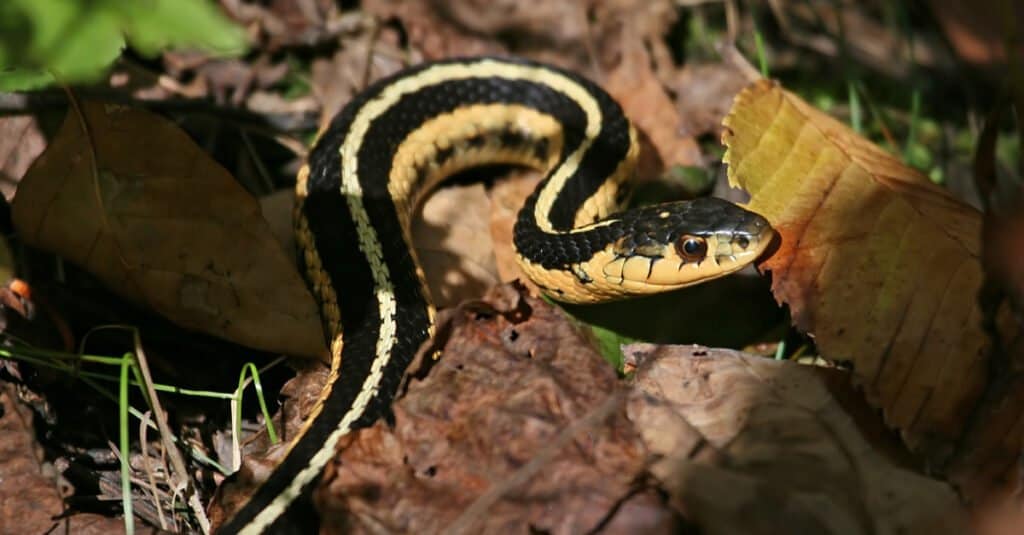
Ribbon snakes are semi-aquatic and eat tadpoles, fish, and amphibians.
©John Czenke/Shutterstock.com
6. Dekay’s Brownsnake (Storeria dekayi)
These little snakes are harder to find than you’d expect. The biggest one on record was only about 19 inches long, and most of them average around 12 inches long. Dekay’s brownsnakes have brown bodies with wide dorsal stripes and sometimes a partial band behind their heads. They hide under leaf litter, rotten logs, and other moist places. They feed on slugs, snails, and earthworms and almost never bite when picked up.
Dekay’s brownsnakes are found along the Saint Lawrence River as far north as Montreal. They aren’t water-loving snakes but live in the same moist areas where they can find their prey.
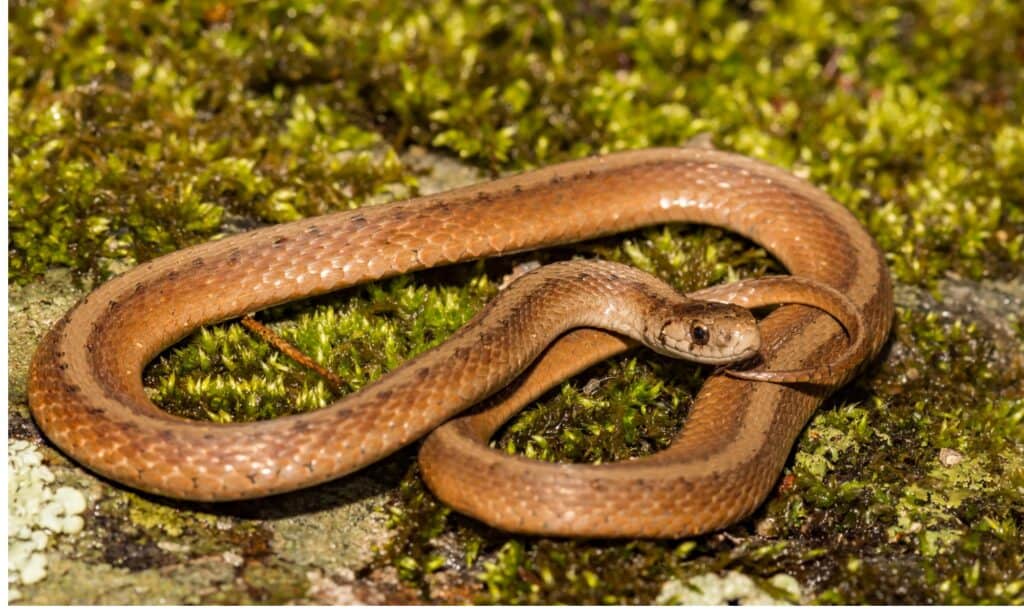
Northern brown snakes are the type species for
Storeria dekayi.
©iStock.com/JasonOndreicka
7. Smooth Green Snake (Opheodrys vernalis)
This bright green snake blends into its grassy habitat so well that you may miss it — even if you’re looking right at one. Smooth green snakes prefer living in marshy grasslands and along the edges of streams without a lot of brush. They only grow to about 20 inches long, and adults have a green dorsal color with some yellow along the belly, which is usually white.
Smooth green snakes eat small prey like small caterpillars, worms, slugs, moths, and spiders. When picked up, they wiggle around a lot until they can wrap around a finger or hand. Along the Saint Lawrence River, these snakes venture as far northeast as the Île d’Orléans, but not much farther.

Smooth green snakes usually eat worms, slugs, moths, caterpillars, and other small invertebrates.
©Kristian Bell/Shutterstock.com
8. Red-Bellied Snake (Storeria occipitomaculatum)
Similar to their sister species, Dekay’s brownsnake, red-bellied snakes hide in leaf litter, under rotten logs, and in other moist places. They’re mainly slug eaters that shy away from attention. Red-bellied snakes are drab on the top but have bright red or orange bellies. These snakes sometimes play dead to avoid predators and rarely bite.
Red-bellied snakes often live alongside rivers and streams like the Saint Lawrence, but not in them. This species lives as far north and east as garter snakes.
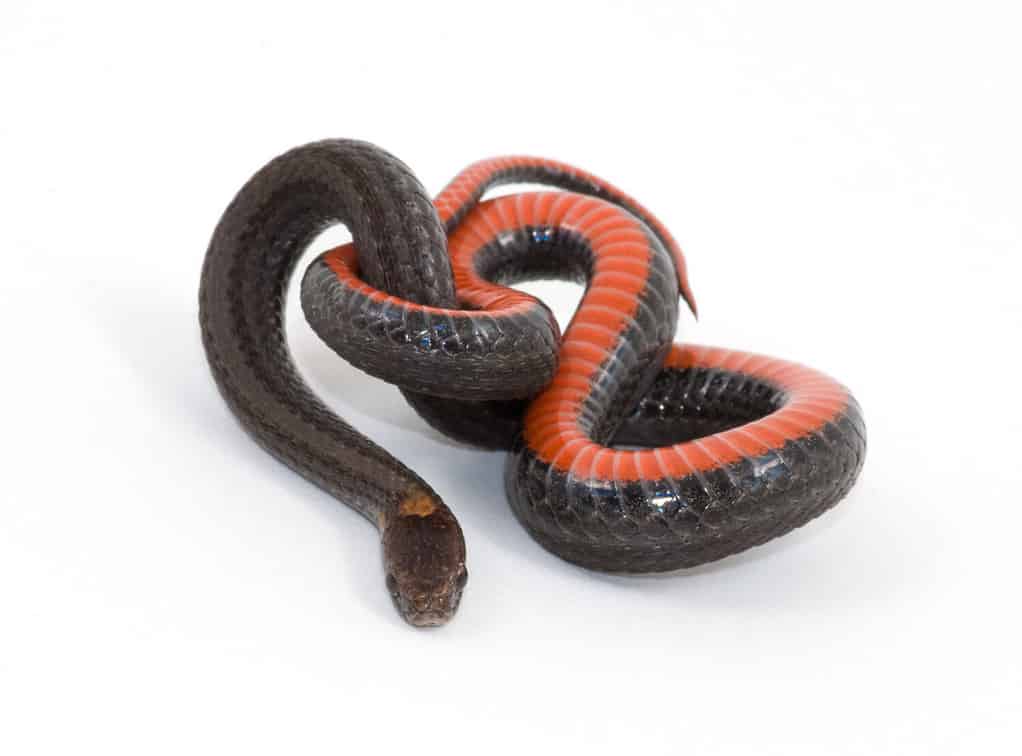
Red-bellied snakes are cousins to Dekay’s brownsnake.
©Gerald A. DeBoer/Shutterstock.com
9. Ring-Neck Snake (Diadophis punctatus)
Another small snake with a brightly-colored belly hides in leaf litter and under rocks and rotten logs! Ring-neck snakes are harmless snakes that grow to about 15 inches as adults. Some scientists recognize up to 14 subspecies, but many others argue that they need more research.
These small and harmless snakes are dark colored on top with a white, yellow, orange, or red belly and matching neckband. They mostly eat earthworms, small salamanders, and slugs; however, they’ll also eat small frogs or toads.
Found along the Saint Lawrence River nearly to the bay, ring-neck snakes are fairly docile and rarely bite. These nonvenomous snakes are harmless to people and pets.
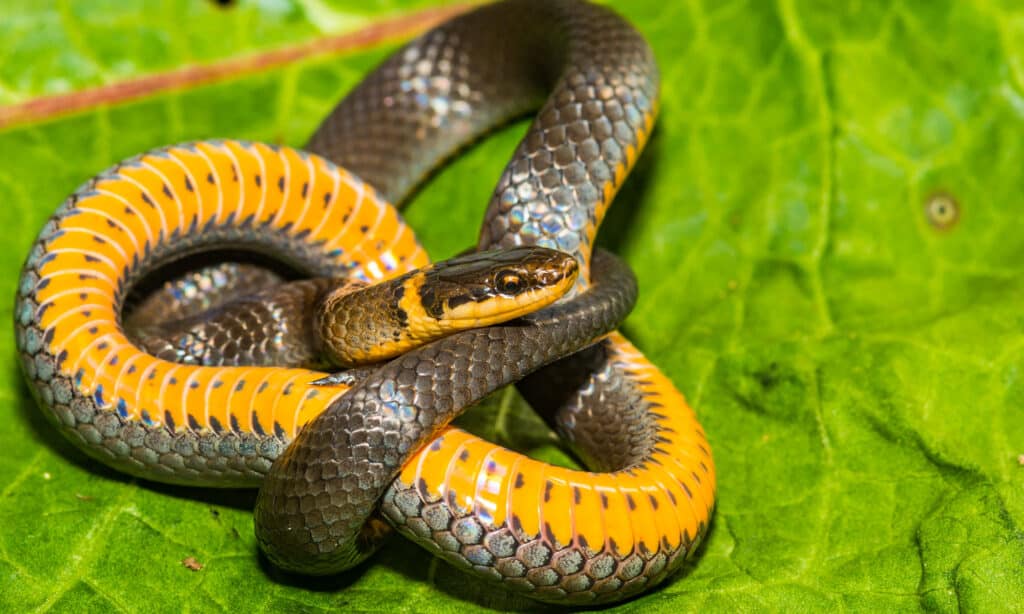
Northern Ringback snake has a bright yellow belly and matching ring around its neck, right behind its head. Ring-necked snakes are small and thin, only measuring about 15 inches long.
©Jay Ondreicka/Shutterstock.com
10. Maritime Garter Snake (Thamnophis sirtalis pallidulus)
One of the only snakes in the northeastern section of the Saint Lawrence River, maritime garter snakes are only about 30 inches long. They have stripes just like other garter snakes, but in many cases, the stripes aren’t as clear as in other garter snakes. These snakes vary in color from brown to green and various shades in between — a checkered pattern between the stripes is also common.
Just like the other garter snakes, they eat earthworms, insects, and amphibians — a mainstay of their diet is small salamanders.
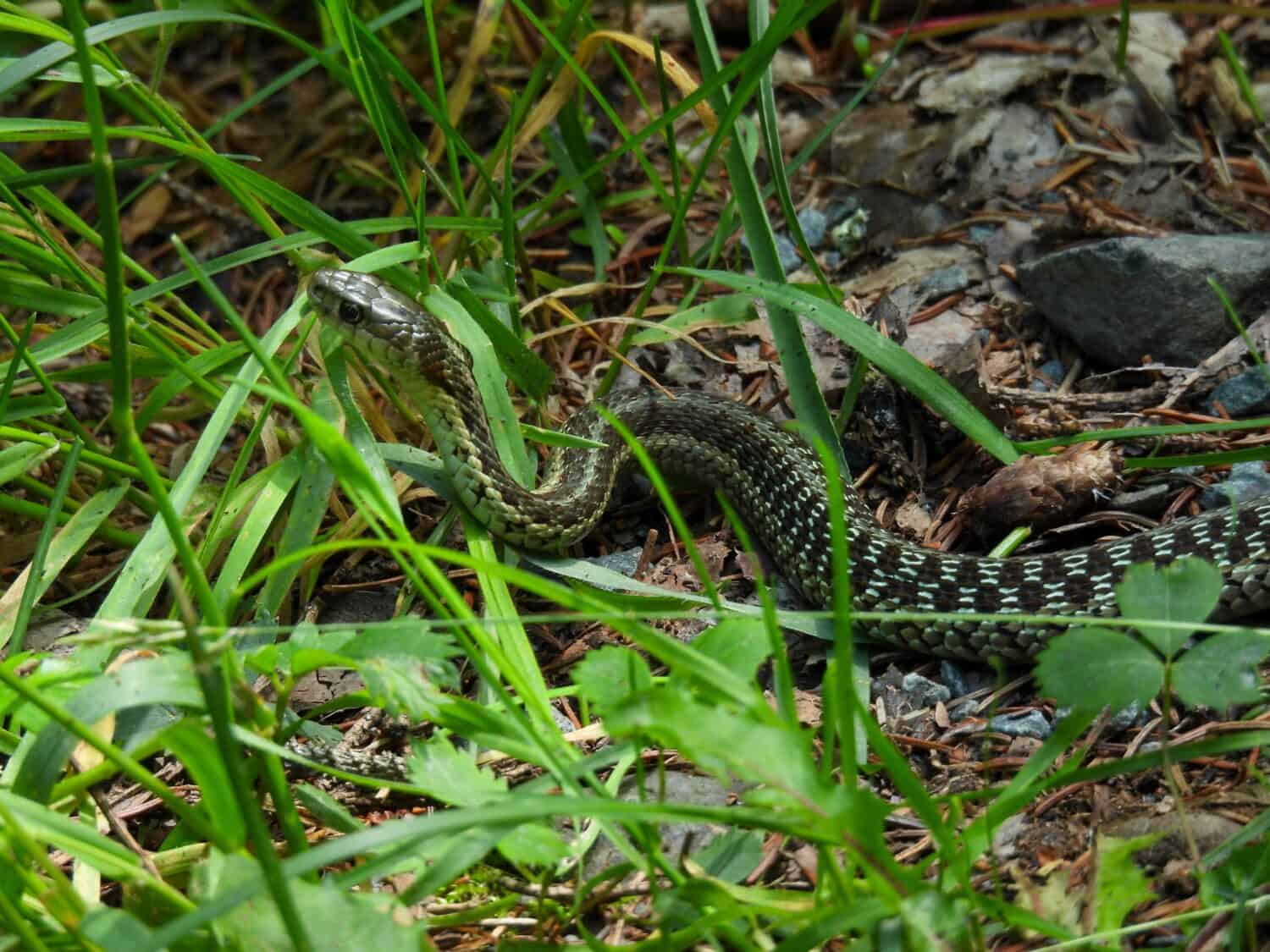
Maritime garter snakes usually have a checkerboard pattern and stripes that aren’t very clear.
©Lisa Crawford/Shutterstock.com
Other Animals Along the St. Lawrence River
Over 6,000 wildlife species make their homes along the Saint Lawrence River. The most visible are the bigger animals or the flying types. However, some are small and really interesting creatures that aren’t as easy to see unless you’re really looking.
- Cross orb weaver (Araneus diadematus) — introduced to North America from Europe, this spider has cross-shaped markings on their backs. They created huge orb webs that capture the insects they eat.
- Northern leopard frog (Lithobates pipiens) — native to parts of the United States and Canada, these are true frogs that grow to about 4.3 inches long from snout to vent.
- Black swallowtail (Papilio polyxenes) — these butterflies are common throughout much of North and South America.
- Barred owl (Strix varia) — in an interesting turn of events, barred owls have managed to expand their territory instead of losing it. They’re mostly native to eastern North America and common around the Saint Lawrence River but have populations on the west coast too.
- Spotted salamander (Ambystoma maculatum) — Although these salamanders can grow to nearly 10 inches long, you may not see them because they spend most of their time underground.
- Hagen’s bluet (Enallagma hageni) — small bright blue damselfly native to North America, primarily in the northeast.
Summary of the 10 Snakes of the Saint Lawrence River
| Name | Length | Feature |
|---|---|---|
| Eastern Garter Snake | up to 4 feet | Semi-aquatic |
| Gray Ratsnake | up to 6 feet | Climber |
| Northern Watersnake | 4 feet | Expert swimmer |
| Eastern Milk Snake | up to 6 feet | Nocturnal |
| Northern Ribbon Snake | 2 feet | Semi-aquatic |
| DeKay’s Brownsnake | 12 inches | Hides under leaves, logs, and moist places. |
| Smooth Green Snake | 20 inches | Lives in marshy grasslands. |
| Red-bellied Snake | 8-10 inches | Hides under leaves, logs, and moist places. |
| Ring-Neck Snake | 15 inches | Hides under leaves, logs, and moist places. |
| Maritime Garter Snake | 30 inches | One of the only snakes in the northeastern section of the Saint Lawrence River. |
The photo featured at the top of this post is © bulbspark/Shutterstock.com
Discover the "Monster" Snake 5X Bigger than an Anaconda
Every day A-Z Animals sends out some of the most incredible facts in the world from our free newsletter. Want to discover the 10 most beautiful snakes in the world, a "snake island" where you're never more than 3 feet from danger, or a "monster" snake 5X larger than an anaconda? Then sign up right now and you'll start receiving our daily newsletter absolutely free.
Thank you for reading! Have some feedback for us? Contact the AZ Animals editorial team.






